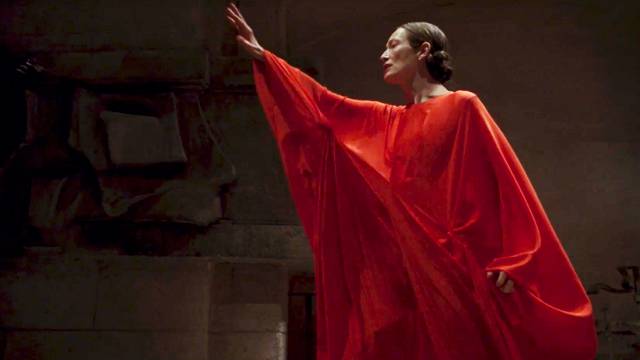The Beauty is Just Skin Deep, by Josh Long
1 Oct
If you’re a horror fan, you eventually come across giallo films, and in doing so, you quickly find out about Dario Argento’s 1977 classic Suspiria. Set in a ballet studio where a coven of witches carry out dark rituals, the film is famous for its vibrant colors, eerie score, and gruesome deaths. Forty years later, Luca Guadagnino (Call Me By Your Name) is trying his hand at this story, although he says it’s more of an “homage” than a “remake.”
Much of the setup is the same as the original. In 1977 Berlin, a young American girl named Susie (Dakota Johnson) comes to a prestigious dance school, which turns out to have some fishy things going on behind the scenes. A space in their dormitory has opened up since another dancer (Chloe Grace Moretz) has mysteriously disappeared. While Argento weaves some mystery before confirming that there are dark rites afoot, Guadagnino quickly reveals that the studio’s teachers are witches. The story then becomes about what the witches want from Susie, and about the elderly psychotherapist who’s trying to track down the missing dancer.
Visually, there’s a lot of great things going on in the film. Unusual edits and camera moves keep the audience feeling off-kilter, threatened. The color isn’t the dazzling technicolor of the original, but there is still an excellent use of palette and contrast. The creative use of sound design builds an ambient sense of dread, something that was also true of the original, if in a different way. The film’s first thirty minutes really draw you in, setting the witches up as a frightening force, and establishing a weird connection between the dancing at the school and their cabalistic rituals.
However, the film begins to lose steam in the second act. While the visual flare is there throughout, the story begins to sink when we start to wonder who the protagonist is. Argento’s Susie remained the protagonist throughout, but Dakota Johnson’s Susie seems to be along for the ride and unafraid of what the coven might do to her. This leaves us with the old man, Prof. Klemperer (puzzlingly played by Tilda Swinton in heavy makeup). He’s the most active character, but besides trying to find the missing girl (who was a patient of his), his connection to the rest of the story seems tenuous. There is a backstory with a wife who was lost during World War II, which gives him depth, but doesn’t validate itself as important to the film’s central story.
Similarly, the film makes much of the backdrop of divided Berlin, but it is unclear to what end. Is the political strain of cold war Germany somehow connected to the witches , or possibly a metaphor for their plots? Maybe it’s just world-building, but such a big deal is made of it, it’s hard to feel it doesn’t mean something deeper. But deeper meanings are either scarce or obtuse here, and it’s hard to tell which. At times, there seems to be a disdain for religion, which the professor compares to collective delusions (and the mass hysteria of Nazism), but then of course the delusion proves true, leaving us confused about the film’s ethos.
In the bizarre finale (which becomes self-indulgent after a while), the film maybe even sort of emerges as pro-witchcraft; my best guess is that is some move to express positives of feminine power. If so, it doesn’t land effectively. True, there is a great deal of mother and birth imagery throughout the film, but none of it really has anything to say about motherhood or birth.
Guadagnino’s “homage” is certainly aesthetically strong; visual, sound and performances are very good. But the story feels weak (especially considering the 152 minute runtime), and ultimately leaves us feeling empty, and a little confused. The re-imagining of Argento’s classic is fun to a degree, but lacks something more substantial in story and theme.




No comments yet